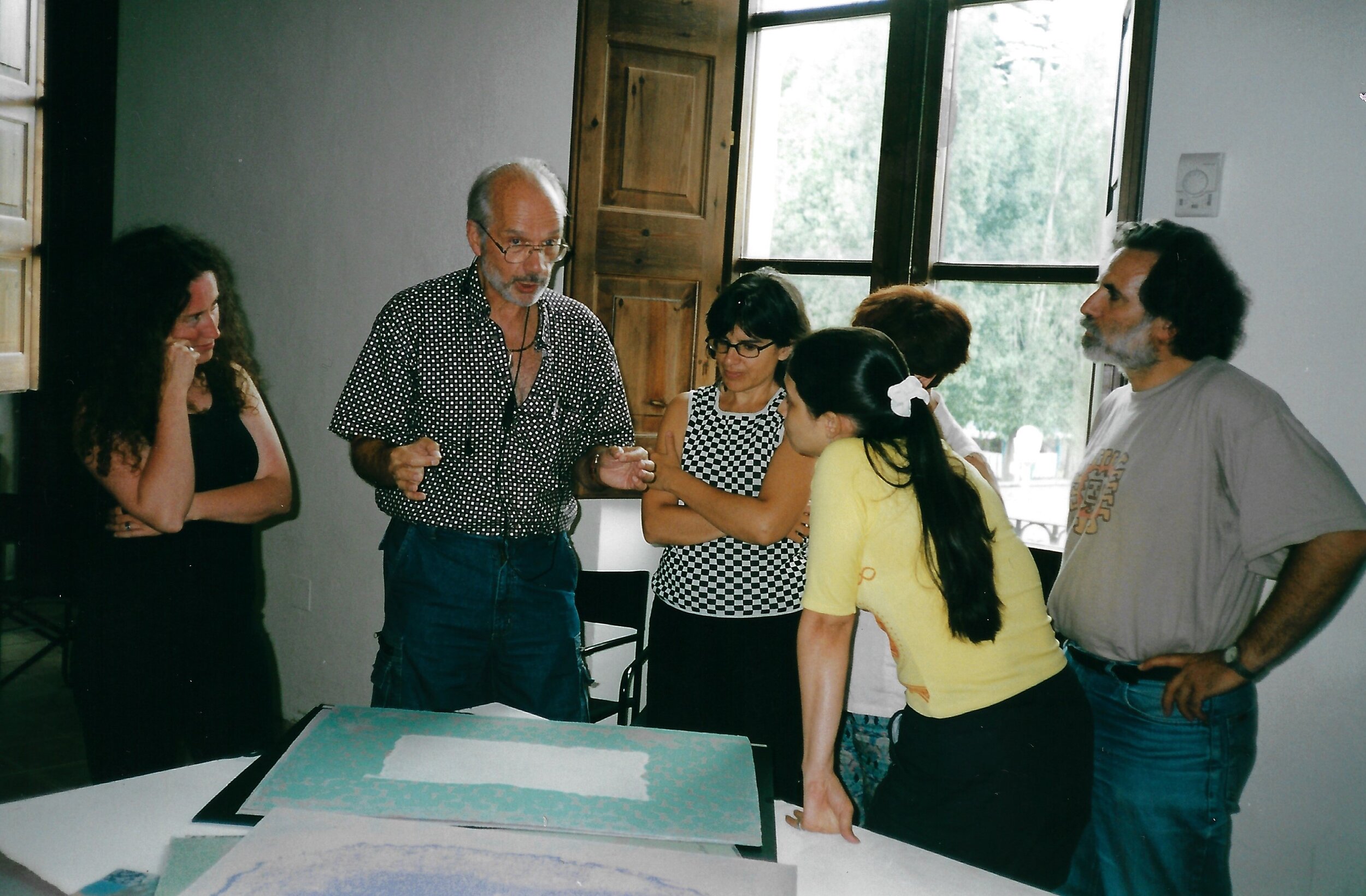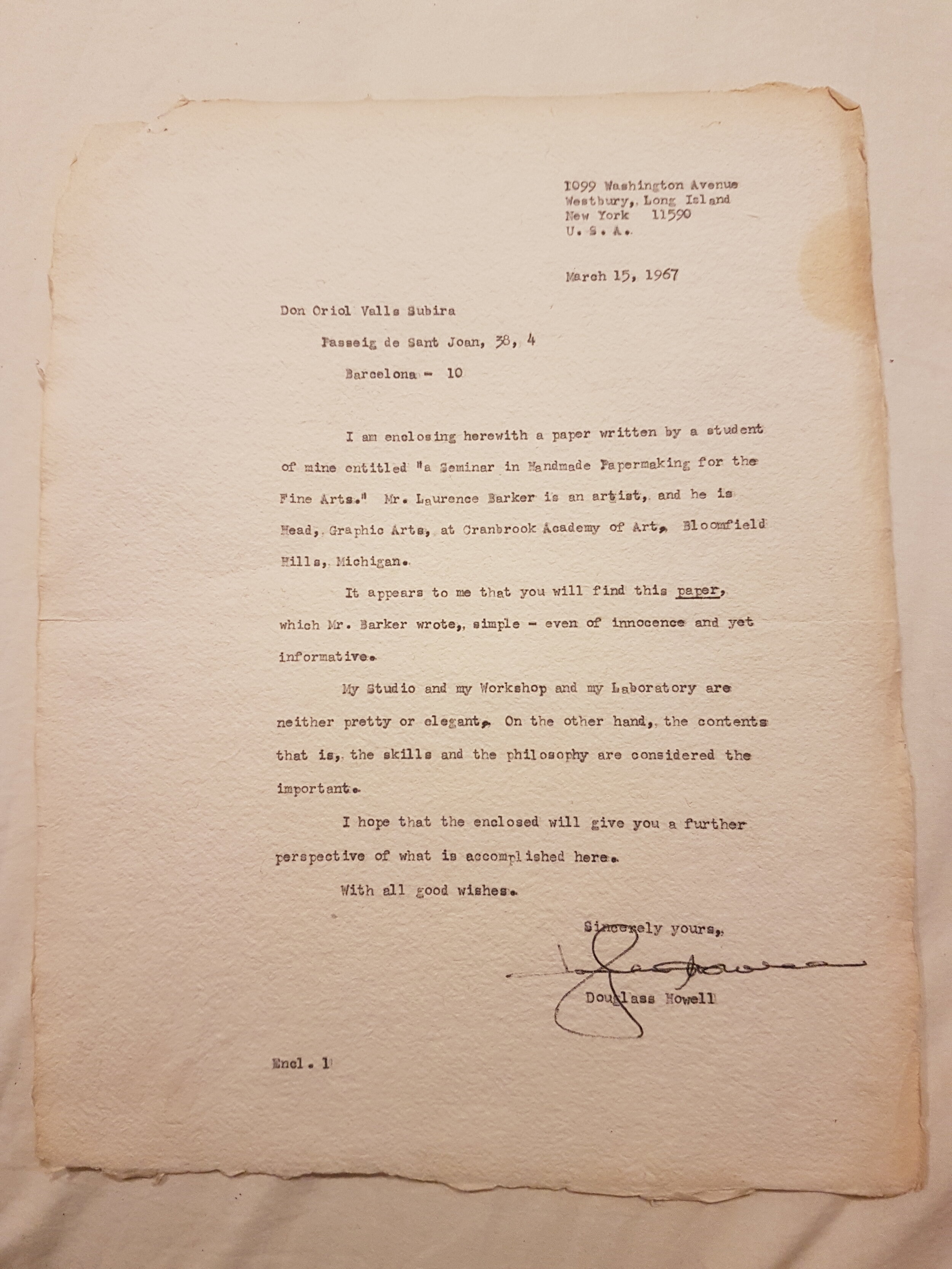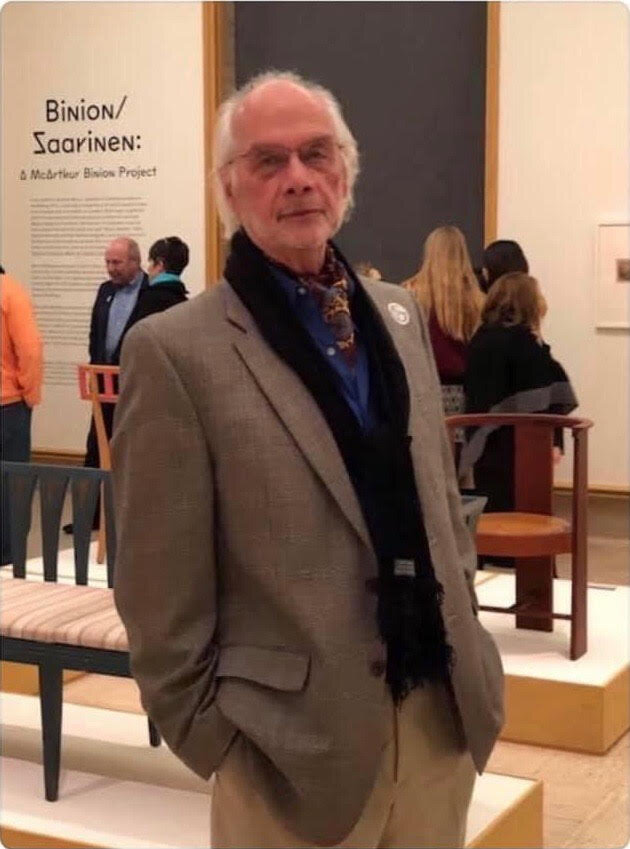
Laurence Barker
PAPERMAKING CHAMPION
“Cranbrook had a small papermaking studio thanks to Laurence Barker, and he had his own work around (because at Cranbrook, every faculty had their own studio that was adjacent to the studios in which they taught). So it was possible to see how he integrated his own printmaking with his papermaking (pink paper!!!!). My strongest memories are of the two of his students--graduate majors in printmaking (I was a major in Sculpture)---who got me in, on the sly, into the print-majors-only paper studio, and--in retrospect--that Laurence did not seem to mind. I owe him a lot for what he made available at Cranbrook and his profound exploratory approach to papermaking. He is also a fine writer with wonderful humor. The papermaking studio at Cranbrook was the first in the country for a graduate school. I went to Cranbrook 1966-68. The papermaking studio that Barker had established at Cranbrook was already there. That early studio and teaching truly underline his creds as a papermaking champion.”
— Winifred Lutz
Laurence Barker
Papermaking Champion
An essay on Laurence Barker, by Victoria Rabal
First of all, I want to thank Lynn Sures for inviting me to write some words about my good friend Laurence Barker.
Laurence Barker was head of the printmaking department at Cranbrook Academy of Art in Bloomfield Hills, Michigan from 1960 to 1970. Crucial in his career was the year 1962 when he attended (as the sole student) a two-week seminar at (Douglas Morse) Howell's Long Island home and mill that summer. He learned from Howell how much paper can be active in Art. In returning to Cranbrook he set up the first university-based papermaking program in America. Barker's program at Cranbrook was “the breeding ground” for some of America's leading papermakers, including Walter Hamady, John Koller, Aris Koutroulis (who, in turn, taught Kathryn Clark of Twinrocker Papers), Winifred Lutz, and Roland Poska.
In 1970, he moved to Barcelona and in 1980 established a paper studio where he made his own work, as well as paper for Roy Lichtenstein, Robert Rauschenberg, Jasper Johns, David Hockney, Mark Tobey, Antoni Tàpies, Chillida, and Joan Miró among others. As Laurence explained to me, Miró likes most the papers with defects because it inspires him. Barker made also very beautiful papers in yellow and blue for the Miró book Càntic al sol edited by Gustavo Gili.
I met him for first time in 1983 at his studio in Ganduxer street in Barcelona. He showed me some of his papers, he talked to me about pulp painting, fibers, rags, papermaking…ARTPAPER ! I remember his vat on a wooden deck, the black hydraulic press that many years later I would buy from him when he moved to U.S.A. –who could have imagined it at that time! But what I will never forget is the emotion I felt once the visit was over and walked down the street with the conviction that a new world had opened for me: the infinitive possibilities of art paper.
At that time I had started working at the The Paper Mill Museum of Capellades, and because of that he encouraged me to organize a workshop in the museum, so the first Art Paper workshop took place in July 1984 with the participation of Laurence Barker and Frederic Amat, among others. It was a success and there were many other workshops in later years. Laurence gave great lectures and workshops, opening a new field of paper and Art to participants.
In 2003, Laurence and I were invited to the Pilar and Joan Miró Foundation in Palma de Mallorca, to give a workshop “Innovations in handmade paper for graphic work.” It was 15 days of intense work with the students and also a time to share a nice time at Mallorca Island.
The last years in Barcelona, Barker came frequently to Capellades and made at the museum’s facilities some of his shaped, perforated pulp paintings “which through their perforations, introduce a form of shadow play”.
Our participation in the Art of pulp painting’s portfolio of Hand Papermaking in 2006 gave us a wonderful opportunity to work together and I learned more closely his papermaking skill while we made the edition of our pieces. For his work Laurence asked me to search rag of different colors, and we made pulp with them in our Hollander. Laurence always remained in his way of making paper without any chemicals, and fiber’s composition of rags (with a range of colors) and some amount of pulp. He told me that if rags had some synthetic fibers it was not a problem, he always makes the comparison of synthetic fibers as breadcrumbs in a hamburger! So these days we also laughed a lot, because with Laurence there is always the complicity in humor , whether speaking or writing
Sometimes life draws surprising lines & circles connecting people from different times and places.
I think this is the most value I can share with the members of the NAHP.
Many years ago I found in the Oriol Valls i Subirá’s legacy (a paper historian and former curator of the Paper Mill Museum of Capellades) some letters and paper samples of Douglass Howell. In one of this letters, one dated in 1967, sent to Mr. Valls he enclosed “a paper written by a student of mine, a seminar in handmade papermaking for fine arts. Mr. Laurence Barker is an artist, and he is Head, Graphic Arts, at the Cranbrook Academy of Art.” In this paper, Barker wrote as a diary all the impressions during the two week workshop:
“My mind then, only a little ruffled with cursory reading, was a tabula rasa with regard to this arcane craft”…. He describes the workshop space “As a matter of fact, monastic is how I should describe the whole house in that this singleness of pursuit, this scholarly devotion to the art of fine papermaking was contained so compactly in a living room filled to the ceiling with fine books and in a basement and laboratory over-crowded with tools essentials to the task”.
“Another view of paper, perhaps seldom ever considered, as that of an independent art form in its own right, I found boldly taken in Mr. Howell’s own brilliantly colored paper compositions made on the mould with colored pulps, half-beatened rags and string”
“Finally, I now attend to last of all, unaccountably, what most well-intentioned people see to first; I should like to acknowledge and express my gratitude to Mr. Howell….”
And I would like to say the same: I will always be grateful for all I learned from him and all the good times we share.
In the last letter he sent me, last week, he agreed I would mention this circle between Howell, Valls, Barker and Rabal… he says to me: “we are history, honey.”
Victoria Rabal
Director
Paper Mill Museum of Capellades
October 24th 2020

"TOP LACING (three)" 1999 pulp painting 21.5" x 30.5"

"NIGHT IN TUNISIA" Var. I / XXV 2000 etching 22.75" x 31"

UNTITLED pulp painting 30" x 22"

UNTITLED pulp painting 22" x 30"





UNTITLED pulp painting 22" x 30"

UNTITLED pulp painting 22" x 30"




Art Paper workshop 2004 Museu Molí Paperer de Capellades


Become an NAHP Member
Join our vibrant hand papermaking community and access your membership benefits.










